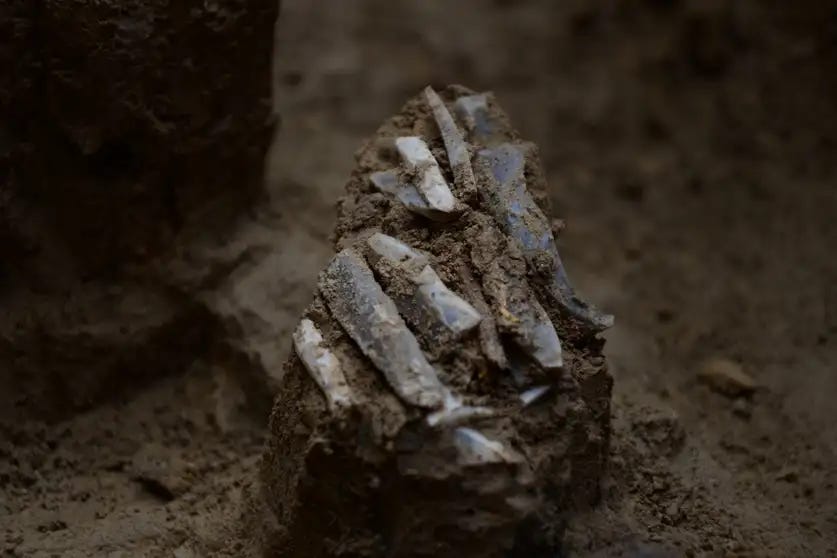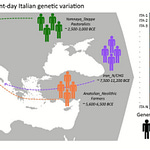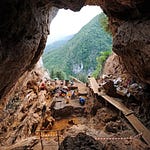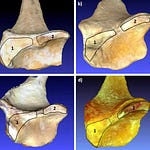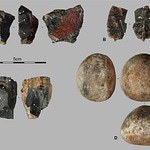In the foothills of the Pavlovské vrchy mountains of southern Moravia, archaeologists uncovered a quiet moment in time: a hunter’s toolkit from the Gravettian period, carefully bundled, forgotten, and buried for some 30,000 years. This is not a cache of ritual offerings or a communal workshop. It is the intimate record of a single person’s gear, frozen in soil and charcoal.
The assemblage, published in Journal of Paleolithic Archaeology1, contains 29 stone tools — blades, points, scrapers and fragments — each one showing the signature wear of use and re-use. Together, they provide a portrait of a hunter-gatherer whose survival depended on mobility, adaptability and memory of distant landscapes.
A Toolkit Unearthed
The discovery at Milovice IV, in the Czech Republic, came from a collapsed cellar first exposed in 2009 and systematically excavated over the following decade. Beneath layers of Pleistocene sediments, researchers led by Dominik Chlachula found traces of hearths, bones of horse and reindeer, and, at the heart of the site, the tightly grouped stone artefacts.
“The artefacts were positioned as though still wrapped in a leather pouch that had long since decayed,” the authors report.
This configuration is what makes the find so unusual. Rather than scattered debris from a workshop, the arrangement suggests a personal kit — a portable toolkit carried on the move.
How a Gravettian Hunter Worked
Close analysis revealed blades dulled by scraping hides and cutting bone, points broken at the tips of spears or arrows, and evidence of hafting. Many of the tools had been reworked from older pieces, implying a strategy of recycling and repair rather than discard.
Some stones tell of journeys far beyond Moravia. Roughly two-thirds of the flint came from glacial deposits over 130 kilometers to the north; other pieces originated in western Slovakia, 100 kilometers to the southeast. Whether these stones were collected directly or acquired through exchange remains unknown, but the distances point to extensive mobility or wide-reaching social ties.
“Several pieces were too worn or broken to be functional,” Chlachula explains in the paper. “It is possible the hunter kept them for future recycling — or perhaps for their symbolic or personal value.”
Mobility and Memory in the Ice Age
The Gravettian period, stretching from roughly 33,000 to 24,000 years ago, represents one of the most distinctive Upper Paleolithic traditions in Europe. These were the makers of the famed Venus figurines, the artists of Pavlovian engravings, and the hunters of mammoth-rich plains. Yet their personal tools are rarely found intact.
This kit from Milovice IV is more than an assortment of stone. It reflects the rhythm of seasonal rounds, the pathways across river valleys and uplands, and the mental maps needed to locate high-quality stone. It also shows how intimate and durable a single pouch of tools could be in Ice Age life.
What Archaeologists Learn from Personal Gear
The discovery brings a level of granularity to Upper Paleolithic life often lost in larger excavations. It allows archaeologists to reconstruct how a single person prepared for travel, hunted, and maintained equipment. This kind of evidence also challenges stereotypes of “disposable” Stone Age tools. Reuse and recycling were central strategies long before agriculture.
It also invites questions about ownership and identity. Was this kit abandoned in haste? Left behind as a personal cache? Or lost when its owner did not return?
Related Research
Verpoorte, A. (2009). Gravettian lithic technology at Pavlov and Dolní Věstonice. Journal of Archaeological Science, 36(3), 993–1005. https://doi.org/10.1016/j.jas.2008.11.002
Svoboda, J. A. (2016). Dolní Věstonice–Pavlov: New excavations and findings. Quaternary International, 415, 254–266. https://doi.org/10.1016/j.quaint.2015.11.063
Zupancich, A., Cristiani, E., et al. (2022). Use-wear and residue analysis of Gravettian stone tools. Journal of Archaeological Method and Theory, 29, 427–451. https://doi.org/10.1007/s10816-021-09540-z
Chlachula, D., Marko, A.-M., Moník, M., Cristiani, E., Gregar, F., Hamrozi, P., Marko, J., Novotný, J., Pluháček, T., Zupancich, A., & Novák, M. (2025). Tracking the Hunter: A study of the personal gear of a gravettian Hunter-gatherer from Milovice IV. Journal of Paleolithic Archaeology, 8(1). https://doi.org/10.1007/s41982-025-00228-z


